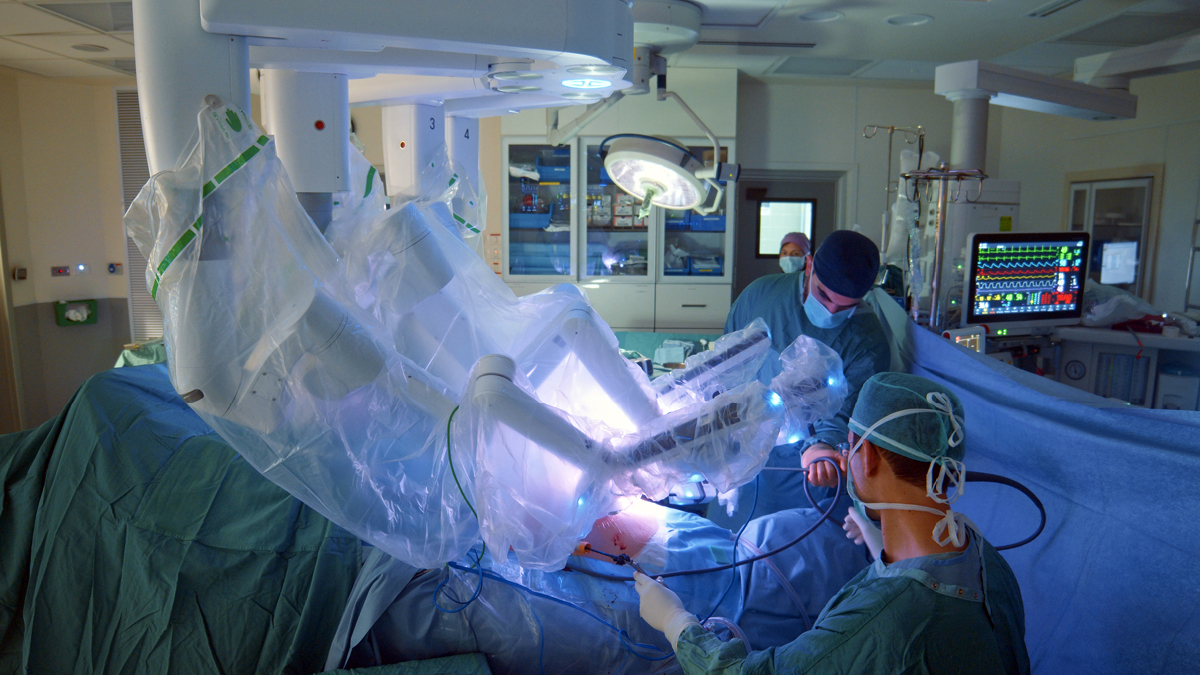Skip to site content

In 1967, surgeons only dreamed of robotic surgical technologies. With the help of the Department of Defense and several adventurous innovators, research agencies began to create the first functional surgical robot only thirty years later.
Currently, multipurpose robotic surgery systems aid physicians in operating rooms worldwide. The original intent of this technology has shifted from battlefield trauma surgeries to minimally invasive procedures.
Surgical technology has come a long way. However, patients and providers report skepticism. So, what are the pros and cons of using robotic surgical technology?
With tiny tools and vivid visualization, image-guided robotic technologies pave the way for minimally invasive surgeries. What was once found only in Sci-Fi movies has become a reality.
Image-guided robotic therapies use magnetic resonance and ultrasound pictures to visualize the treatment area. Cameras are attached to a tiny probe, inserted into a small incision, and utilized for superior visualization with minimal cutting. This innovative imaging technology allows surgeons to perform minimally invasive procedures.
Many assume that minimally invasive interventions simply mean surgeons make a smaller cut. This belief is a myth. Minimally invasive surgical procedures require special tools and advanced education for maximum results.
Traditional tools and the surgeon’s hands are bulky, requiring a large incision. With thin, robotic instruments and a tele-manipulator, surgeons skillfully and precisely direct the robot’s movements.
The benefits of robotic interventions and minimally invasive surgical techniques are most evident in the short-term outcomes. Compared to traditional methods, these benefits directly result in smaller incisions and reduced internal trauma.
Traditional surgical methodologies require large incisions that cut through muscles and tendons to expose the affected area. However, with image-guided robotics, surgeons can access the surgical site with minimal internal disruption. These benefits often result in the following outcomes:
Patients are generally pleased with the results, but image-guided robotic interventions also benefit surgeons. Many report the following advantages of using these technologies:
Though this new technology requires additional training for surgeons, many claim that embracing minimally invasive techniques has improved surgical outcomes and elevated their practice.
As with all invasive procedures, robotic surgeries also come with a degree of risk. Patients and providers must evaluate if the benefits of utilizing these innovations are worth the risks.
Though surgeons typically place patients in a natural position, sometimes access to the surgical site requires patients to be placed in an abnormal position. Unnatural positioning for prolonged periods puts patients at risk of injury.
Compared to manual methods, robotic tools give less tactile feedback, making it more challenging to feel adjacent organs. Many surgeons report that imaging and training address this concern.
The lack of standardization is the most significant disadvantage of using robotics during surgery. Training is typically done online with limited surgical supervision. However, hospitals with high-quality standards proactively oversee their surgeons and determine qualifiers for using these tools and techniques.
Robotic equipment is expensive, which may increase the overall surgical cost. However, reduced hospital stays and rehabilitation requirements may balance the financial scale.
We all know that technology is wonderful when it works. However, relying on robotics can be risky, even with regular maintenance. Technical difficulties can elongate surgical times and require surgeons to perform manual intervention.
Image-guided robotic systems show phenomenal short-term benefits when compared to traditional methods. However, the long-term benefits are comparable. Patients and providers must consider if the benefits outweigh the risks.
Robotic technology is more than a possibility. It is a phenomenal reality. Every day, surgeons worldwide utilize image-guided robotics to perform procedures that were once highly invasive and physically traumatic. Some common minimally invasive surgeries using robotic technology are the following:
Image-guided robotic technology used for minimally invasive surgeries delivers many benefits. As with all invasive interventions, robotic surgeries also have some degree of risk. However, with highly trained surgeons, patients benefit from the many advantages of minimally invasive surgeries.
“Image-Guided Robotic Interventions.” NIH: National Institute of Biomedical Imaging and Bioengineering, 2016, Image-Guided Robotic Interventions.
“Origins of Robotic Surgery: From Skepticism to Standard of Care.” NIH: National Library of Medicine, 2018, Origins of Robotic Surgery: From Skepticism to Standard of Care – PMC.
“12 Pros and cons of the Da Vinci Robotic Surgery.” HRF: Health Research Funding, 2023, 12 Pros and cons of the Da Vinci Robotic surgery – HRF.
Subscribe to our MEDforum e-newsletter for the latest guidelines and information from Up Health.